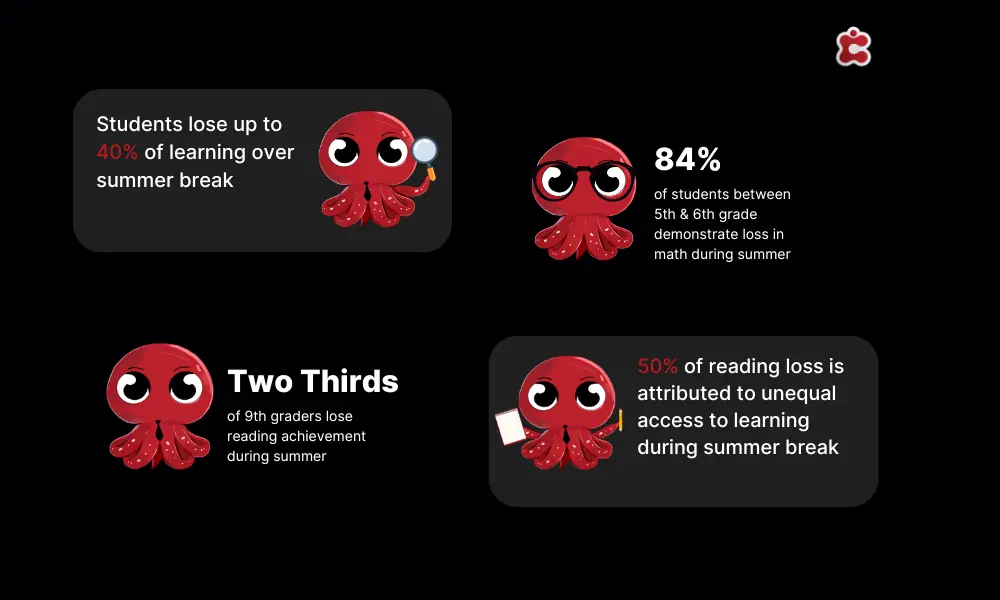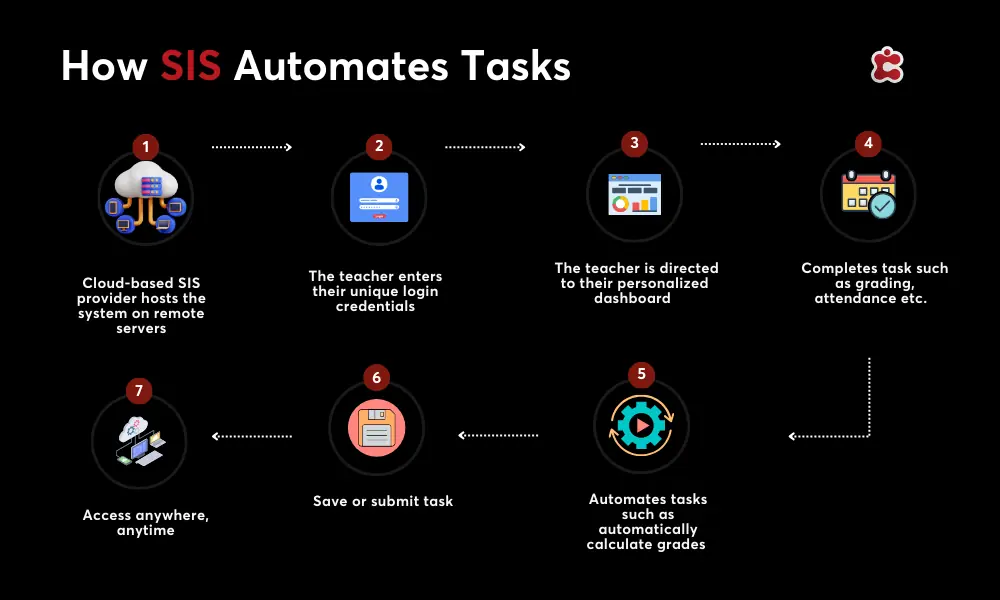Summer has come and gone, leaving behind memories, new friendships—and, for many students, a little too much-forgotten knowledge. If you’re a teacher or school administrator, you know exactly what we mean. That moment in the fall when students struggle to remember lessons they had down cold just a few months ago? Yep, that’s summer learning loss in action.
This academic backslide hits some students harder than others, especially in subjects like math and reading. And it doesn’t stop there. Kids from underserved communities often fall even further behind, widening the achievement gap year after year.
But here’s the good news: It doesn’t have to be this way. With the right tools, schools can predict learning gaps, run targeted programs, and kick off the new year without missing a beat. A Student Information System (SIS) is key to making it happen.
We’ll show you how to use your SIS to tackle summer learning loss head-on and set students up for success—this year and beyond. Because while summer may be fleeting, your student’s progress doesn’t have to be.

What is Summer Learning Loss?
Summer learning loss is what happens when students forget essential skills during the long break. After weeks away from classrooms, routines, and structured learning, it’s no surprise that some knowledge slips away—especially in subjects like math and reading. Research shows that between 70% and 78% of students across elementary grades experience a drop in math skills over the summer. And for kids in grades three through five, about 20% of the progress they made in reading vanishes by the time school starts again.
Unfortunately, this learning loss doesn’t affect all students equally. Kids from economically disadvantaged backgrounds often feel the brunt of it. Without access to summer camps, reading programs, or enrichment activities, they fall behind even further—widening the achievement gap year after year. For these students, every new school year can feel like climbing uphill from the start.
In the short term, summer learning loss forces teachers to hit pause on new content and spend the first few weeks re-teaching old material. This can be stressful for students and educators, creating a bumpy start to the academic year. But the long-term consequences are even more concerning—repeated learning loss across summers can accumulate, leading to lower grades, decreased motivation, and less college readiness down the line.
Why You Should Use Your SIS to Address Summer Learning Loss
Now that summer has gone, it’s time for schools to refocus and tackle the challenges that come with returning to the classroom. Using a Student Information System can be pivotal in addressing summer learning loss. Here’s how your SIS can help schools hit the ground running:
- Identify Learning Gaps: After summer, your SIS can analyze assessment data to pinpoint which students experienced the most significant learning loss. This information helps educators prioritize interventions for those who need it most.
- Customized Reinforcement Plans: With the insights gained from your SIS, teachers can develop personalized reinforcement plans for each student, ensuring they receive targeted support to regain lost knowledge and skills quickly.
- Streamlined Communication: The SIS can facilitate effective communication between teachers, students, and parents, making it easier to share updates on student progress and highlight resources that can aid in catching up.
- Tracking Progress Over Time: By consistently monitoring student performance through your SIS, educators can track improvements, celebrate small victories, and make necessary adjustments to support ongoing growth.
- Resource Accessibility: Your SIS can serve as a central hub for educational resources, providing students with access to supplemental materials, online courses, and enrichment activities that encourage continued learning and engagement.
Implementing Post-Summer Learning Programs
Getting students back on track after summer break doesn’t have to be overwhelming. With the right approach using your SIS, schools can effectively implement a post-summer learning program. Here’s a step-by-step guide to help you get started:
1. Start by using your SIS to review students’ performance data from the previous year. Identify any learning gaps, especially in core subjects like math and reading. This will help you understand where the focus should be.
2. Bring together teachers, administrators, and parents to discuss the learning gaps identified. Gathering input from everyone involved will ensure a more comprehensive understanding of student needs and set the stage for collaboration.
3. Use your SIS to create personalized learning plans for each student. These plans should target specific skills and knowledge areas that need reinforcement, ensuring every student has a clear roadmap for success.
4. With the identified gaps in mind, design post-summer programs or after-school enrichment activities that cater to those needs. Utilize your SIS to schedule these programs and manage enrollments seamlessly.
5. Once the programs are underway, regularly check in on student progress using your SIS. This will help you assess the effectiveness of your initiatives and make adjustments as needed to support continuous improvement.
6. Keep families informed about their child’s progress and program updates through your SIS’s communication tools. Regular updates help build a strong partnership between school and home.
Preventing Future Summer Learning Loss with SIS
The key to tackling summer learning loss is not just reacting to it after the break but taking proactive steps to prevent it. With an SIS, schools can create continuous learning paths that stretch beyond the academic calendar. These plans provide students with structured activities and enrichment opportunities to follow during the summer, reducing the risk of setbacks. When students return, they can pick up right where they left off, making the transition into a new school year smoother and more effective.
SIS platforms also offer powerful data analytics, allowing schools to identify students who might struggle before summer even begins. By using predictive insights, teachers can create personalized intervention plans tailored to the unique needs of each student. Whether it’s targeted assignments or online learning modules, these interventions give students a head start, ensuring they don’t fall behind over the break.
Keeping students engaged throughout the summer is equally important, and this is where SIS platforms with gamification tools come in handy. Incorporating quizzes, challenges, and rewards into learning keeps students motivated, even when school is out. These interactive elements make learning feel less like work and more like play, helping students stay mentally active.

Classter’s SIS: Combat Summer Learning Loss
Don’t let summer learning loss become a recurring hurdle—Classter’s SIS is here to make sure students stay on track, even after long breaks. With Classter, schools have everything they need to identify learning gaps, personalize support, and keep academic progress on course, ensuring students return to class ready to thrive.
One of the biggest advantages of Classter’s SIS is real-time data tracking. Teachers can quickly see where students left off before summer and where they need the most support. This allows schools to create personalized learning plans tailored to each student’s needs, so no one falls behind.
Classter also makes managing summer programs simple. Whether your school offers enrichment programs, catch-up courses, or extracurricular activities, Classter streamlines the entire process—enrollment, scheduling, and attendance tracking are handled with ease.
Get ahead of the curve with Classter. Book a demo today to see how our SIS can help your school tackle summer learning loss, support student success, and make back-to-school season stress-free.
FAQ’s
Summer learning loss refers to the decline in academic skills and knowledge that occurs when students are away from structured learning during long breaks, especially in core subjects like math and reading.
An SIS helps track student progress, identify learning gaps early, and support personalized interventions before and after the summer. It also facilitates communication between teachers, parents, and students to ensure continued academic engagement during breaks.
Classter’s SIS offers advanced data tracking, seamless summer program management, and personalized learning plans. Its predictive analytics allow educators to take early action, ensuring students return to school ready to succeed.

